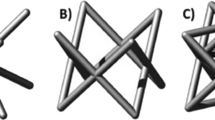Abstract
Analytical and numerical analyses for predicting the mechanical responses of BCC and FCC lattice structures under compressive loading were performed and verified by comparing them to experimental data. The analytical and numerical results are in excellent correlation, while the error between the experimental and numerical results is about 5.8 ~ 15.3 %, which was caused by the inconsistent lattice strut diameter and the material elastic modulus. The measured lattice strut diameter is smaller than the designed diameter by thermal shrinkage, so the thermal shrinkage should be taken into the lattice structure design in additive manufacturing processes. Based on the same analytical and numerical techniques, a parametric investigation of the elastic moduli of BCC and FCC lattice unit cells with respect to the strut aspect ratio, specific density and strut angle was performed. Finally, the elastic moduli of multi-cell BCC and FCC lattice structures with the same density were investigated by varying the number of rows and columns of lattice unit cells in both unconstrained and constrained boundary conditions. As the strut aspect ratio, density and angle increase, the elastic moduli of both BCC and FCC lattice increase. FCC elastic modulus is higher than that of BCC lattice with respect to the strut aspect ratio, density and angle, while BCC elastic modulus could be found to be higher than of FCC lattice for a constrained boundary condition.
Similar content being viewed by others
References
V. V. Vasiliev and A. F. Razin, Anisogrid composite lattice structures for spacecraft and aircraft applications, Composite Structures, 76 (1) (2006) 182–189.
B. Jenett, S. Calisch, D. Cellucci, N. Cramer, N. Gershenfeld, S. Swei and K. C. Cheung, Digital morphing wing: active wing shaping concept using composite lattice-based cellular structures, Soft Robotics, 4 (1) (2017) 33–48.
D. Rosen, S. Johnston, M. Reed and H. Wang, Design of general lattice structures for lightweight and compliance applications, Rapid Manufacturing Conference, Loughborough University (2006).
J. Niu, Study on lattice structures using additive manufacturing and its application on a new ultra-lightweight vehicle suspension system, Ph.D. Thesis, University of Nottingham, UK (2017).
K. Ushijima, W. J. Cantwell, R. A. W. Mines, S. Tsopanos and M. Smith, An investigation into the compressive properties of stainless steel micro-lattice structures, J. of Sandwich Structures and Materials, 13 (3) (2010) 303–329.
Q. Feng, Q. Tang, Y. Liu and R. Setchi, Theoretical analysis of the mechanical response of lattice structures manufactured using selective laser melting, KES Transactions on SDM II -Sustainable Design and Manufacturing, 8 (2) (2015) 400–411.
M. SadeghYazdi, S. A. Latifi Rostami and A. Kolahdooz, Optimization of geometrical parameters in a specific composite lattice structure using neural networks and ABC algorithm, J. of Mechanical Science and Technology, 30 (4) (2016) 1763–1771.
E. Ptochos and G. Labeas, Elastic modulus and poisson’s ratio determination of micro-lattice cellular structures by analytical, numerical and homogenisation methods, J. of Sandwich Structures and Materials, 14 (5) (2012) 597–626.
V. Dakshnamoorthy and R. M. Taylor, Automated lattice optimization of hinge fitting with displacement constraint, Solid Freeform Fabrication 2016: Proceedings of the 26th Annual International (2016) 2123–2138.
M. Smith, W. J. Cantwell, Z. Guan, S. Tsopanos, M. D. Theobald, G. N. Nurick and G. S. Langdon, The quasi-static and blast response of steel lattice structures, J. of Sandwich Structures and Materials, 13 (4) (2010) 479–501.
J. Nguyen, S. Park, D. W. Rosen, L. Folgar and J. Williams, Conformal lattice structure design and fabrication, 23rd Annual International Solid Freeform Fabrication Symposium -An Additive Manufacturing Conference (2012) 138–161.
M. Smith, Z. Guan and W. J. Cantwell, Finite element modelling of the compressive response of lattice structures manufactured using the selective laser melting technique, International J. of Mechanical Sciences, 67 (2013) 28–41.
A. Panesar, M. Abdi, D. Hickman and I. Ashcroft, Strategies for functionally graded lattice structures derived using topology optimisation for additive manufacturing, Additive Manufacturing, 19 (2018) 81–94.
G. N. Labeas and M. M. Sunaric, Investigation on the static response and failure process of metallic open lattice cellular structures, Strain, 46 (2) (2008) 195–204.
D. Gundapaneni, J. T. Tsatalis, R. T. Laughlin and T. Goswami, Wear characteristics of WSU total ankle replacement devices under shear and torsion loads, J. of the Mechanical Behavior of Biomedical Materials, 44 (2015) 202–223.
T. Duda and V. Raghavan, 3D metal printing technology, IFAC-PapersOnLine, 49 (29) (2016) 103–110.
Author information
Authors and Affiliations
Corresponding author
Additional information
Recommended by Associate Editor Beomkeun Kim
Sung Hoon Kim received his Ph.D. degree from Chonnam National University, Korea, in 1999. Kim is currently a Professor in the Department of Automotive Mechanical Engineering at Nambu University in Kwangju, Korea. His research interests are focused on multiphysics, co-simulation of multi body dynamic with nonlinear finite element method, additive manufacturing and pyrolysis-thermo-mechanical analysis.
Rights and permissions
About this article
Cite this article
Lee, KW., Lee, SH., Noh, KH. et al. Theoretical and numerical analysis of the mechanical responses of BCC and FCC lattice structures. J Mech Sci Technol 33, 2259–2266 (2019). https://doi.org/10.1007/s12206-019-0427-6
Received:
Revised:
Accepted:
Published:
Issue Date:
DOI: https://doi.org/10.1007/s12206-019-0427-6




